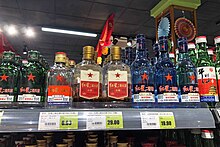 Bottles of the two most famous brands of erguotou, Red Star and Niulanshan (at far right) | |
| Type | Baijiu, Qingxiang |
|---|---|
| Manufacturer | Beijing Hongxing, Niulanshan, Beijing Erguoutou, Huadu, Xinhuamen, and others. |
| Country of origin | China |
| Region of origin | Beijing |
| Introduced | Qing Dynasty |
| Alcohol by volume | 42–65% |
| Colour | Clear |
| Ingredients | Sorghum |
| Erguotou | |||||||||
|---|---|---|---|---|---|---|---|---|---|
| Simplified Chinese | 二锅头 | ||||||||
| Traditional Chinese | 二鍋頭 | ||||||||
| Literal meaning | "second pot head" (second distillation) | ||||||||
| |||||||||

Erguotou (Chinese: 二锅头; pinyin: èrguōtóu; lit. 'second pot head', ' i.e. second distillation') is a style of qingxiang baijiu originating in Beijing and primarily made in the region surrounding.[1][2]
The process of erguotou production is what sets it apart from other qingxiang baijiu's like Fenjiu. Three ingredients, sorghum, fuqu (麸曲; a wheat bran based qū), and water make up the ingredient base. The sorghum is crushed, cooked, cooled, and mixed with the qū before being added, in a liquid state, to a stone or steel fermentation vessel where it will be left to ferment for a relatively short period of about four to eight days. After the qū has converted the starches and sugars in the sorghum into ethanol, the grain is transferred to a still that will extract the ethanol from the mixture. The distilled output is then rested in ceramic jars for a relatively short six to twelve months before being blended, proofed, bottled, and sold.[1][2][3]
The relatively short fermentation time, and the stone or steel fermentation vessel result in less production of esters overall. For that reason, erguoutou is a milder spirit than other baijius in terms of aroma.
- ^ a b Sandhaus, Derek (31 May 2014). Baijiu: The Essential Guide to Chinese Spirits. Penguin Group. pp. 53–54, 118–119. ISBN 9780143800132.
- ^ a b Sandhaus, Derek (11 December 2018). "Better Know a Baijiu: Light Aroma". drinkbaijiu.com. Drink Baijiu: The World of Chinese Spirits.
- ^ Xiaowei, Zheng; Beizhong, Han (March 2016). "Baijiu (白酒), Chinese liquor: History, classification and manufacture". Journal of Ethnic Foods. 3 (1): 19–25.